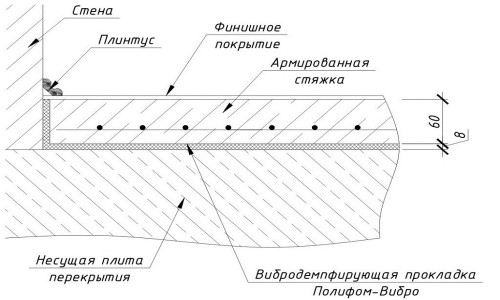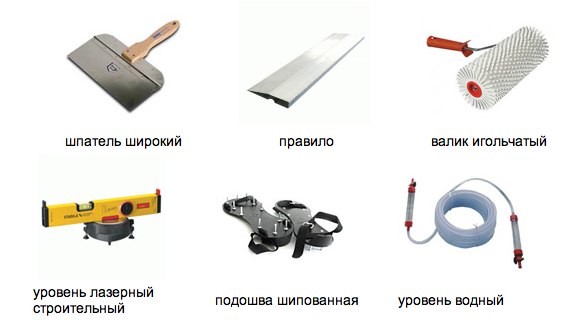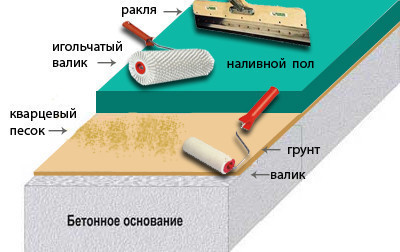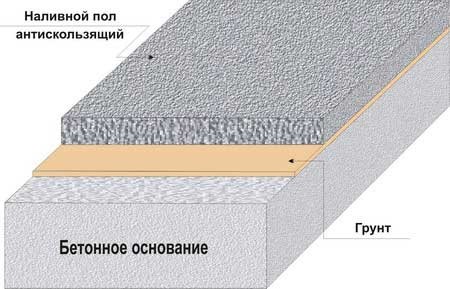One of the main stages of any capitalrepairs in an apartment or a private house is the leveling of floors. This work is quite complex and requires maximum responsibility and attention from the performer. Among modern methods of constructing floor coverings, self-leveling bulk mixtures are very popular, with which the process of pouring floors is significantly simplified. Floor screed diagram.Self-leveling floor, spreading, forms a flat, strong and smooth surface, which is perfect for further finishing with laminate, linoleum, ceramic tiles, etc. Therefore, below we will consider how to make a self-leveling floor with your own hands.
Floor screed diagram.Self-leveling floor, spreading, forms a flat, strong and smooth surface, which is perfect for further finishing with laminate, linoleum, ceramic tiles, etc. Therefore, below we will consider how to make a self-leveling floor with your own hands.
Preparatory work
 Necessary tools for self-leveling floors. To carry out installation work, you will need the following tools and materials:
Necessary tools for self-leveling floors. To carry out installation work, you will need the following tools and materials:
- Electric drill or perforator with a special nozzle for mixing the solution;
- wide spatula;
- needle and cloth roller;
- kraskostupy;
- brush;
- solution tank;
- self-leveling mixture;
- a deep penetration primer.
For 1 m² of floor with a thickness of 1 mm, you will need about 1.8 kg of dry mix. Therefore, for example, to fill a base of 15 m² with a thickness of 5 mm, you will need: 1.8 * 5 * 15 = 135 kg of dry mix. Scheme of self-leveling self-leveling floor.After removing the old floor covering, you need to check the strength of the base, the presence of chips, cracks and other visible defects. If such places are found, they should be repaired with a regular cement-sand mortar. Pay special attention to the difference in heights over the entire finishing area. The difference between the smallest and largest heights should be no more than 3 cm. Next, the floor is cleaned of all kinds of debris and dust, since their presence significantly reduces the adhesion of the self-leveling mixture. The entire base must be thoroughly treated with a deep penetration primer. It is recommended to apply the primer with a brush or a fabric roller in 2 layers. To prevent liquid solution from leaking out through the doorway, a special barrier is installed, which can be made from improvised means (for example, from boards). After the preparation of the base for pouring is complete, you can proceed to mixing the solution. To do this, the purchased dry mixture must be poured into a container with water in certain proportions indicated on the package. In this case, the solution should be thoroughly mixed, for which you can use an electric drill or a hammer drill with a special attachment. Pouring the floor is possible while the mixture is liquid. Over time, it begins to thicken, so after its preparation, you must immediately proceed to installation work. Return to the table of contents</a>
Scheme of self-leveling self-leveling floor.After removing the old floor covering, you need to check the strength of the base, the presence of chips, cracks and other visible defects. If such places are found, they should be repaired with a regular cement-sand mortar. Pay special attention to the difference in heights over the entire finishing area. The difference between the smallest and largest heights should be no more than 3 cm. Next, the floor is cleaned of all kinds of debris and dust, since their presence significantly reduces the adhesion of the self-leveling mixture. The entire base must be thoroughly treated with a deep penetration primer. It is recommended to apply the primer with a brush or a fabric roller in 2 layers. To prevent liquid solution from leaking out through the doorway, a special barrier is installed, which can be made from improvised means (for example, from boards). After the preparation of the base for pouring is complete, you can proceed to mixing the solution. To do this, the purchased dry mixture must be poured into a container with water in certain proportions indicated on the package. In this case, the solution should be thoroughly mixed, for which you can use an electric drill or a hammer drill with a special attachment. Pouring the floor is possible while the mixture is liquid. Over time, it begins to thicken, so after its preparation, you must immediately proceed to installation work. Return to the table of contents</a>
Pouring a self-leveling compound
Floor pouring work should be carried out at an ambient temperature of +10 to +30°C and a relative humidity of no more than 65%. Liquid anti-slip floor diagram.Also, there should be no drafts in the room where the pouring is being done, so all windows and doors must be closed. The prepared solution is poured over the base in strips about 25-45 cm wide, after which they are evenly leveled with a wide spatula. After that, the distributed mixture is rolled out with a needle roller. This procedure removes all air bubbles from the solution layer, which significantly increases the strength of the future coating. In this case, all work is carried out in paint shoes. After covering the entire base, it is necessary to let it dry and gain strength. Depending on the thickness of the self-leveling floor, this can take from 2 days to 2 weeks.
Liquid anti-slip floor diagram.Also, there should be no drafts in the room where the pouring is being done, so all windows and doors must be closed. The prepared solution is poured over the base in strips about 25-45 cm wide, after which they are evenly leveled with a wide spatula. After that, the distributed mixture is rolled out with a needle roller. This procedure removes all air bubbles from the solution layer, which significantly increases the strength of the future coating. In this case, all work is carried out in paint shoes. After covering the entire base, it is necessary to let it dry and gain strength. Depending on the thickness of the self-leveling floor, this can take from 2 days to 2 weeks.


